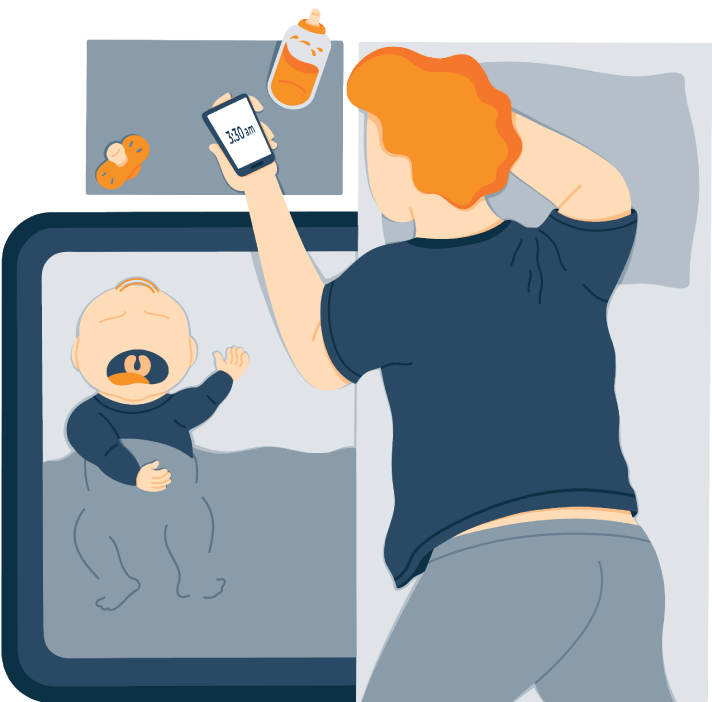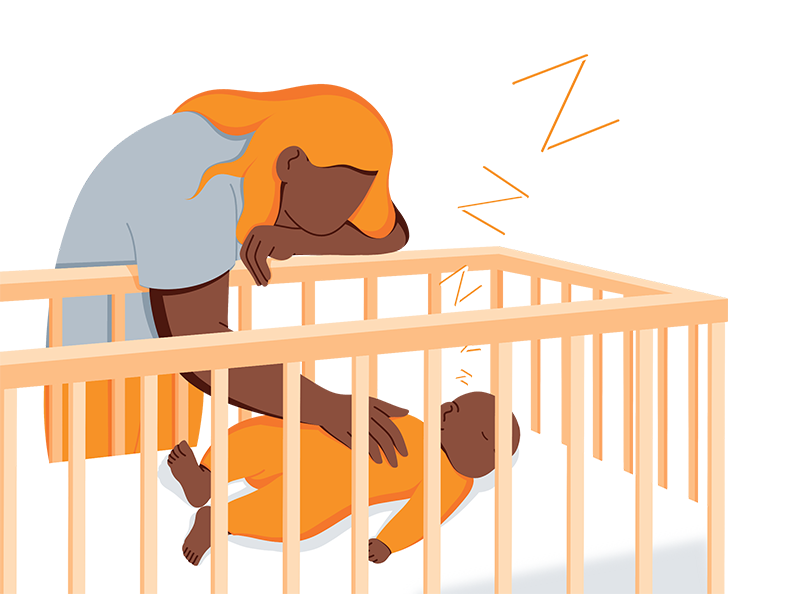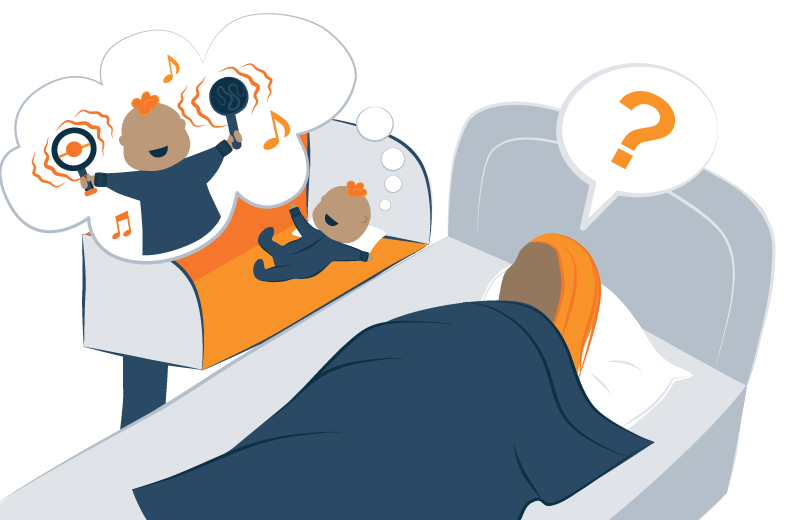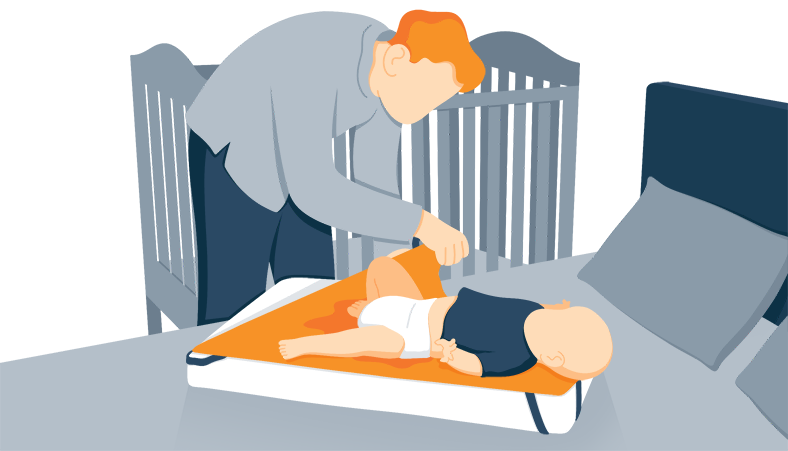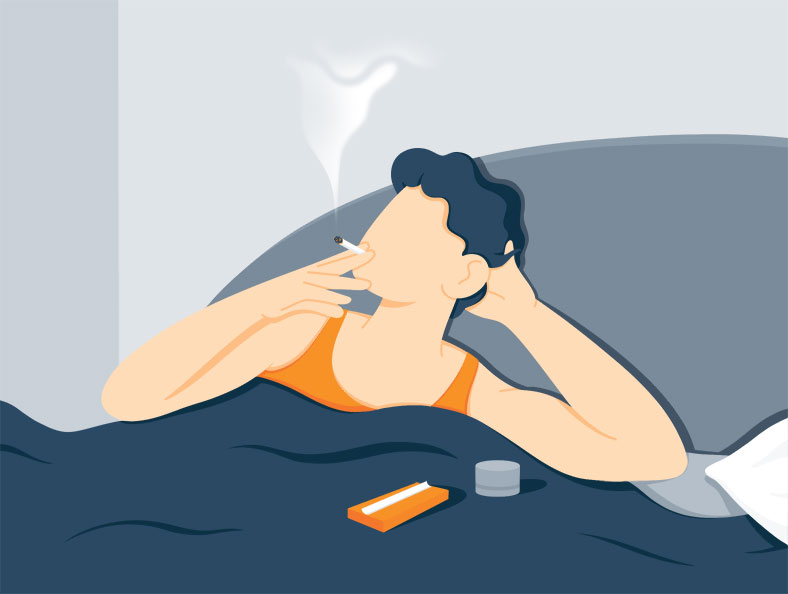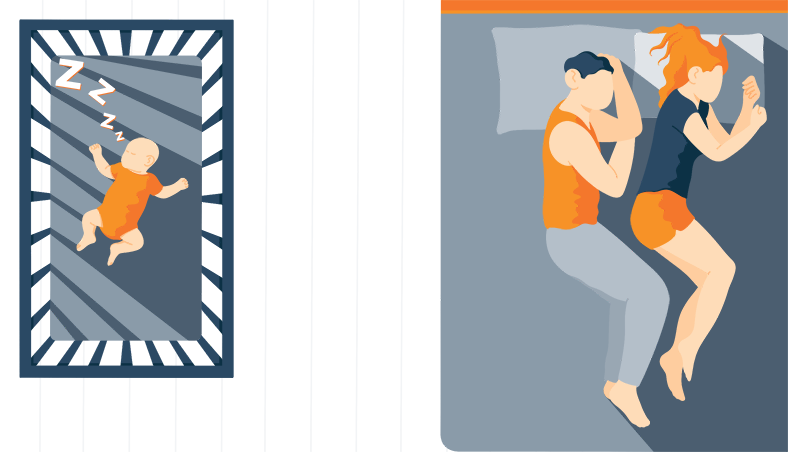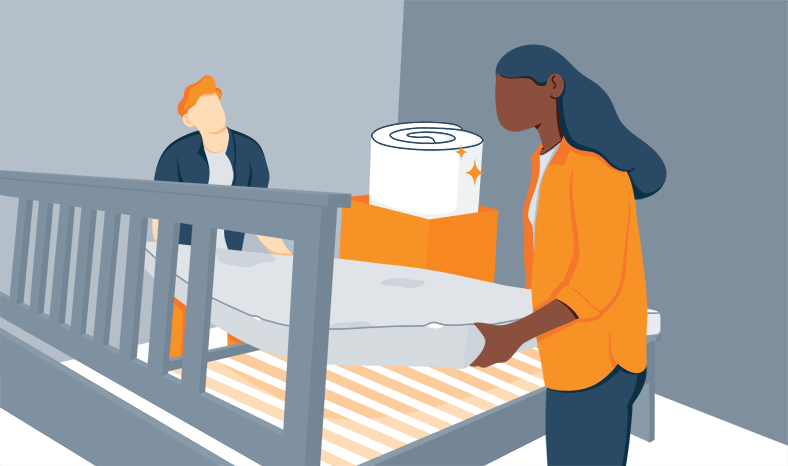As you research ways to help your baby fall asleep quickly while remaining safe and secure through the night, you may have come across the idea of co-sleeping.
If you are a new parent, you’ve already got a lot on your plate, and we are here to help you separate fact from fiction. We have compiled research from professional pediatric health resources to provide you with details on safe co-sleeping, the potential risks and benefits, and some helpful sleeping arrangements to consider for your family.
Before you read on, would you mind helping us gather some research?
What Is Co-Sleeping?
Co-sleeping1 is when a baby shares a sleeping environment with their parents. While some parents may prefer this method to feel closer to their infant, depending on how it’s executed, co-sleeping does come with some significant risks for the child.
Bed-sharing is a form of co-sleeping in which parents share a bed with their baby, and this type of co-sleeping is very dangerous, sometimes leading to sudden infant death syndrome (SIDS)1.
An adult bed presents more safety hazards for a young child compared to a crib or a toddler bed. For example, a softer mattress or loose bedding products such as pillows and blankets could suffocate the infant2. The baby could also become trapped between objects or strangled by something nearby, such as a chord from the window blinds2. Furthermore, a parent could roll over while asleep and accidentally suffocate the child2.
Stephanie Hewitt, founder of Stephanie Hewitt Sleep Consulting, recommends that “a child should have their own sleep space free from blankets, toys, and other people that may unintentionally crowd the sleep space.”
Also, you should especially avoid sharing beds with babies who are at a high risk of SIDS, such as newborns, babies with low birth weight, and preterm infants2.
Want to know more? Read our 7 safety tips on When Your Baby Can Sleep with a Blanket
Bedside Co-Sleeper Arrangement
A bedside co-sleeper3 is a bassinet or crib that attaches to the side of the parents’ bed but still gives the baby a separate space to sleep. As a result, the parent and child are at approximately the same level, and they have physical access to each other.
Debbie Gerken, founder of Sleep Like a Baby Consulting, affirms that bedside co-sleepers are a safer option than bed-sharing. “These bedside sleepers can help create an environment that is close to the parents yet can be kept safe by having a firm mattress without any additional products like pillows or blankets”.
View Our Guide: Best Baby Co-sleeper
Room Sharing
The American Academy of Pediatrics4 (AAP) recommends room-sharing as the safest choice for a co-sleeping arrangement, adding that it reduces the risk of SIDS by as much as 50 percent. This means, the baby’s crib or bassinet is in the parents’ bedroom, but it is not attached to the bed. The AAP also says that a baby having their own sleeping space helps prevent the child from becoming trapped, suffocated, or strangled4.
When room sharing, the parents can bring the baby to the adult bed to breastfeed or provide comfort, and then return the baby to their crib or bassinet to sleep safely.
The advantage of this arrangement is that the parents can still be nearby for safety and security while allowing the child to sleep in their own space. Also, as the baby grows and enters the toddler stage, this could help them better prepare for falling asleep in their room.
Child Welcomed into the Parents’ Bedroom as Needed
Another safe sleeping arrangement is when the baby has a separate bedroom but can sleep in the parents’ bedroom when needed. When a baby wakes up during the night, they typically want the comfort of their parents. To ensure that this arrangement is safe, it is wise to keep a crib or bassinet in the parents’ bedroom if the baby wants to sleep there instead of their own bedroom.
5 Benefits of Co-Sleeping
1. Co-Sleeping Reduces Stress for the Baby
Both the parents and the baby may have separation anxiety5 at night. An infant has been attached to their mother for nine months, and the idea of being alone could be stressful.
A 2011 study6 looked at the effects of separating 25 infants from their mothers for sleep training. Even though the babies were no longer crying out by the third night, their cortisol – or stress – levels remained high6. Thus, keeping your baby in the same room as you might decrease your baby’s stress levels.
Not only that, but it could decrease your own stress and anxiety, as you can keep a closer eye on your little one.
2. It’s Easier to Check on the Infant
When your baby is in the room with you, it’s easier to check in on them during the night; you won’t have to trek down the hall to make sure everything is okay. Also, you’ll be able to hear your baby more easily in case they are in distress.
3. May Lead to More Sleep for Parents and Baby
Experts say that co-sleeping also helps both babies and parents sleep longer7, which is likely due to reduced stress and increased ease in checking in on the baby at night.
Better rest is vital for parents’ physical and emotional health as they navigate raising a baby. More sleep helps parents make better decisions and lowers the risk of postpartum depression7.
4. Bottle or Breastfeeding is Easier When Co-Sleeping
Newborns typically sleep in one or two-hour increments and will likely wake up at night to eat8.
Having your baby in the same room as you is also more convenient when it is time to breastfeed or give them a bottle. The infant is at arm’s length or a few feet away for an impromptu feeding session in a co-sleeping arrangement.
5. Co-Sleeping Can Foster a Better Bond With the Father
While we may associate co-sleeping as primarily something a mom does for easier breastfeeding or bonding, this sleeping arrangement can also benefit fathers7.
A 2012 study9 examined how different forms of co-sleeping affected testosterone levels in male parents and found that dads who co-slept with their babies showed lower testosterone levels. These findings indicate that lower testosterone is correlated with more gentle, sensitive, responsive parenting9.
How to Safely Co-Sleep
We want to emphasize that it’s not recommended to share a bed with a baby1. However, if you decide to do so, there are certain tips to help you share a bed more safely.
Infant Should Be Older Than Six Months
Rather than allowing a newborn to sleep beside you immediately, the AAP advises you to never share a bed with an infant under six months of age10.
Instead, you can set up their crib in your bedroom and have the child sleep there. This way, the baby is still in the room with you during the night but isn’t at an increased risk of danger. There is always a risk of SIDS when bed-sharing with a baby, so we suggest that you keep your baby in their own sleeping space, such as a crib or bassinet.
No Smoking, Use of Medication, or Substance Abuse
If you or your partner is a current smoker, the infant should not sleep in the same bed10. Parents should also avoid sleeping next to a baby after consuming 10. Certain medications can also make it harder for you to wake up10.
Furthermore, it is good to avoid any other irritants11 that could bother the child’s airways. For example, avoid strong-smelling hairsprays, deodorants, and perfumes as these could make it difficult for them to breathe or cause coughing and choking11.
Parents Shouldn’t Be Overly Tired
Being a parent, especially with a young child, can make it challenging to get adequate sleep. In addition, those who have a sleep disorder such as sleep apnea could also feel more tired than usual12 since it can be difficult to obtain quality rest.
You should never sleep next to your child if you are exhausted, since you’ll probably be less likely to wake up if your baby is stuck or suffocating. If you usually feel extra sleepy, your best bet is to set up a room-sharing arrangement instead.
Baby Should Only Share the Bed With a Parent
Though it’s not recommended, if you choose to bed-share with your child, the baby should only share a bed with a parent, not with their siblings. We suggest this because other children will likely not wake up if the baby is in distress or is being strangled or suffocated.
Don’t Bed-Share With More Than One Person
If your baby shares a bed with more than one parent, that just increases the risk that they will be suffocated or strangled accidentally. So, in the event you decide to bed-share, make sure there is only one parent in the bed with the baby. For those who share a bed with a partner, this means that a separate bed space for the baby would be a safer option.
As mentioned, though, the AAP says room sharing is the safest choice.4 Furthermore, your baby should never sleep alone in an adult bed without a parent, as this is a major risk of SIDS.2
Sleep On a Firm Bed
If you choose to bed-share, your bed should be conducive to safe sleeping with a baby. The mattress should be firm and void of soft items on the bed such as pillows, comforters, blankets, or stuffed toys2. Firm mattresses are safest for babies as they reduce the risk of suffocation2. Additionally, a King size mattress also allows for extra space for the parent and child.
How to Make Your Bed a Safer Environment
Along with using a firm mattress, there are other ways to create a safe sleep environment for your baby.
The bedding and the mattress should be secure with no cracks, crevices, or ways for a baby’s limbs to get stuck2.
Couches are also considered a high-risk overnight sleep space for babies because these furniture pieces are too plush for a baby to sleep on, risking suffocation. Additionally, the crevices between and behind the cushions present a significant threat, as the baby can get stuck. There is also a risk of your baby falling or rolling off of a couch.
The University of Notre Dame13 also adds that the infant should not be near any blinds or items in the room with cords as they could cause strangulation. Long hair could also be hazardous, so make sure to have your hair tied back and inaccessible to the baby13.
We advise that parents who are overweight room-share with their bed as opposed to bed-sharing, as there is a higher risk of suffocation. Lastly, if you bed-share you should never let the child fall asleep on your chest; they should lie directly on the bed.
Additional Safety Tips
Whether your little one shares a bed with you, sleeps adjacently, or is in a crib in the same room, you should also follow the instructions listed below14 for safe sleeping.
- The baby should sleep on their back.
- Put the baby in minimal clothing, so they don’t get too hot.
- Do not cover the infant’s head.
Want to know more? Check out our complete guide to safe sleep for babies.
Frequently Asked Questions
Are bed rails recommended?
Bed rails might seem like a great way to keep a baby secured, but the U.S. Consumer Product Safety Commission15 states that bed rails are dangerous for children under the age of two, increasing the baby’s risk of becoming trapped or even dying.
However, the U.S. Food and Drug Administration16 (FDA) says bed rails are safe for small children old enough to get in and out of bed independently, specifically ages two through five.
When should you stop co-sleeping?
Pediatric authorities17 recommend that infants stay in the same room with their parents until they are between six and 12 months old to reduce the risk of SIDS. Once a baby turns one year old, the risk of SIDS decreases18, so you may want to stop room-sharing when your child hits that milestone.
Does co-sleeping cause separation anxiety?
You may have concerns as to whether co-sleeping can lead to separation anxiety as the child matures. According to Greater Good Magazine, children who shared a bed adjusted to sleeping on their own about a year later than other kids7. However, they may be more self-sufficient and confident in their everyday lives compared to children who didn’t co-sleep7.
What are the different types of co-sleepers?
Parents have plenty of options to choose from regarding the type of bed they want for their child. For example, parents may opt for a crib, special co-sleeper bed, or bassinet instead of placing the child directly in the bed with them.
Certain co-sleeper beds are specifically designed to be placed right next to mom and dad’s bed. For instance, some can be formally attached and removed as needed, and they may have different height options to match the height of the adult bed.
These bedside co-sleepers will also typically have a side panel that opens. The opening side door allows mom or dad to have direct access to the baby during the night.
Bassinets are a great option for room-sharing as well. Parents can place the bassinet right next to their bed or several feet away.
Some bassinets, like cribs, are convertible, providing extra convenience for the child and parents. For example, they can be used at the crib level or removed for travel. Furthermore, certain convertible bassinets can transition with the baby as they grow into the toddler stage.
How common is SIDS?
According to Boston Children’s Hospital19, approximately 2,300 infants in the United States die from sudden infant death syndrome each year. However, following the safety guidelines set forth by pediatric healthcare professionals should help reduce a child’s risk of SIDS.
Experts do not know what causes SIDS, but they hypothesize that it is linked to several circumstances. These include the child’s inability to wake up from sleeping, notice low oxygen levels, or detect an excess of carbon dioxide in their bloodstream19.
The following factors put babies at an increased risk of SIDS19:
- Stomach or side sleeping
- Overheating
- A plush sleep space that also includes soft blankets or toys
- Mothers who smoked during their pregnancy are three times more likely to have an infant with SIDS
- Exposure to smoke, either direct or passive
- Mothers younger than 20 years old during their first pregnancy
- When the mother has had minimal to no prenatal care – or care given too late during her pregnancy
- The baby was born premature or had a low birth weight
- The child has a sibling who died of SIDS
Jill Zwarensteyn
Editor
About Author
Jill Zwarensteyn is the Editor for Sleep Advisor and a Certified Sleep Science Coach. She is enthusiastic about providing helpful and engaging information on all things sleep and wellness.
Combination Sleeper
References:
- Thoman, Evelyn B. “Co-sleeping, an ancient practice: issues of the past and present, and possibilities for the future”. Sleep Medicine Reviews. https://www.sciencedirect.com/science/article/abs/pii/S1087079205001267. 2006.
- “Sudden infant death syndrome (SIDS)”. Mayo Clinic. Last modified July 19, 2024. https://www.mayoclinic.org/diseases-conditions/sudden-infant-death-syndrome/symptoms-causes/syc-20352800.
- Moon MD, Rachel Y., Kington, Marit., et. al. “Physician Recommendations Regarding SIDS Risk Reduction: A National Survey of Pediatricians and Family Physicians”. Sage Journals. https://journals.sagepub.com/doi/abs/10.1177/0009922807303894?journalCode=cpja. 2007.
- Moon MD, Rachel Y. “SIDS and Other Sleep-Related Infant Deaths: Expansion of Recommendations for a Safe Infant Sleeping Environment”. American Academy of Pediatrics. https://publications.aap.org/pediatrics/article/128/5/1030/30941/SIDS-and-Other-Sleep-Related-Infant-Deaths?autologincheck=redirected. 2011.
- “Separation Anxiety”. Children’s Hospital of Philadelphia. Webpage accessed August 2, 2024. https://www.chop.edu/conditions-diseases/separation-anxiety.
- Middlemiss, Wendy., Granger, Douglas A., Goldberg, Wendy A., Nathans, Laura. “Asynchrony of mother–infant hypothalamic–pituitary–adrenal axis activity following extinction of infant crying responses induced during the transition to sleep”, Early Human Development. https://www.sciencedirect.com/science/article/abs/pii/S0378378211002702. 2011.
- Divecha, Diana. “How Cosleeping Can Help You and Your Baby”, Greater Good Magazine. https://greatergood.berkeley.edu/article/item/how_cosleeping_can_help_you_and_your_baby. 2020.
- “How Much and How Often to Breastfeed”. Centers for Disease Control and Prevention. https://www.cdc.gov/nutrition/infantandtoddlernutrition/breastfeeding/how-much-and-how-often.html#:~:text=On%20average%2C%20most%20exclusively%20breastfed,on%20the%20time%20of%20day. 2022.
- Gettler, Lee T., McKenna, James J., et. al. “Does Cosleeping Contribute to Lower Testosterone Levels in Fathers? Evidence from the Philippines”. National Library of Medicine. https://www.ncbi.nlm.nih.gov/pmc/articles/PMC3434197/. 2012.
- “American Academy of Pediatrics Updates Safe Sleep Recommendations: Back is Best”. American Academy of Pediatrics. Webpage accessed August 2, 2024. https://www.aap.org/en/news-room/news-releases/aap/2022/american-academy-of-pediatrics-updates-safe-sleep-recommendations-back-is-best/#:~:text=AAP%20recommends%20that%20parents%20sleep,the%20baby%20receives%20routine%20immunizations.
- Zhou, Jiaqi., Tierney, Neena K., et. al. “Estimating infants’ and toddlers’ inhalation exposure to fragrance ingredients in baby personal care products”. International Journal of Occupational and Environmental Health. https://www.ncbi.nlm.nih.gov/pmc/articles/PMC6147117/. 2018.
- “Sleep Apnea”. Mayo Clinic. Last modified April 6, 2024. https://www.mayoclinic.org/diseases-conditions/sleep-apnea/symptoms-causes/syc-20377631#:~:text=The%20repeated%20awakenings%20associated%20with,TV%20or%20even%20when%20driving.
- “Safe Cosleeping Guidelines”. University of Notre Dame. Webpage accessed August 2, 2024. https://cosleeping.nd.edu/safe-co-sleeping-guidelines/.
- Moon MD, Rachel Y. “How to Keep Your Sleeping Baby Safe: AAP Policy Explained”. American Academy of Pediatrics Healthy Children.org. Last modified July 14, 2022. https://www.healthychildren.org/English/ages-stages/baby/sleep/Pages/A-Parents-Guide-to-Safe-Sleep.aspx.
- “CPSC Adopts New Federal Standard for Portable Bed Rails”. United States Consumer Product Safety Commission. https://www.cpsc.gov/Newsroom/News-Releases/2012/CPSC-Adopts-New-Federal-Standard-for-Portable-Bed-Rails. 2012.
- “Adult Portable Bed Rail Safety”. United States Food and Drug Administration. Webpage accessed August 2, 2024. https://www.fda.gov/medical-devices/consumer-products/adult-portable-bed-rail-safety.
- McCarthy MD, Claire. “Room sharing with your baby may help prevent SIDS, but it means everyone gets less sleep”. Harvard Health. https://www.health.harvard.edu/blog/room-sharing-with-your-baby-may-help-prevent-sids-but-it-means-everyone-gets-less-sleep-201706062525. 2020.
- “SIDS by Baby’s Age Infographic (Text Alternative)”. National Institute of Child Health and Human Development. Webpage accessed August 2, 2024. https://safetosleep.nichd.nih.gov/resources/social-digital/sids-by-babys-age-infographic-text-alternative#:~:text=SIDS%20is%20less%20common%20after,before%206%20months%20of%20age.
- “Sudden Infant Death Syndrome (SIDS)”. Boston Children’s Hospital. Webpage accessed August 2, 2024. https://www.childrenshospital.org/conditions/sudden-infant-death-syndrome-sids#symptoms-and-causes.

